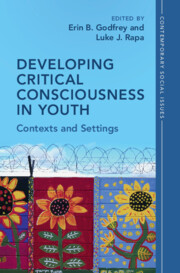Book contents
- Developing Critical Consciousness in Youth
- Contemporary Social Issues Series
- Developing Critical Consciousness in Youth
- Copyright page
- Dedication
- Contents
- Figures
- Tables
- Contributors
- Acknowledgments
- Introduction
- Part I Pedagogical, Curricular, and School-Based Contexts
- Part II Extracurricular Contexts
- Part III Societal Contexts
- 7 Critical Race Consciousness
- 8 The Quest for Racial Justice
- 9 Critical Consciousness Development among Undocumented Youth
- 10 Influences of Sense of Social Responsibility, Immigrant Bargain, and Immigrant Optimism on Critical Consciousness Development among Immigrant Youth of Color
- Concluding Thoughts on the Role of Contexts and Settings in Youth Critical Consciousness Development
- Index
- References
9 - Critical Consciousness Development among Undocumented Youth
State of the Science, Historiography of Immigration Policy, and Recommendations for Research and Practice
from Part III - Societal Contexts
Published online by Cambridge University Press: 11 May 2023
- Developing Critical Consciousness in Youth
- Contemporary Social Issues Series
- Developing Critical Consciousness in Youth
- Copyright page
- Dedication
- Contents
- Figures
- Tables
- Contributors
- Acknowledgments
- Introduction
- Part I Pedagogical, Curricular, and School-Based Contexts
- Part II Extracurricular Contexts
- Part III Societal Contexts
- 7 Critical Race Consciousness
- 8 The Quest for Racial Justice
- 9 Critical Consciousness Development among Undocumented Youth
- 10 Influences of Sense of Social Responsibility, Immigrant Bargain, and Immigrant Optimism on Critical Consciousness Development among Immigrant Youth of Color
- Concluding Thoughts on the Role of Contexts and Settings in Youth Critical Consciousness Development
- Index
- References
Summary
Critical consciousness has been established conceptually and by research as an empowering tool that supports the development of youth facing social oppression. An evolving body of literature suggests that critical consciousness can also be helpful for undocumented immigrant youth, a group that is impacted by a history of racialized anti-immigrant policy that more harshly disadvantages people of color (e.g., Indigenous People, Latinx, Black, and Asian). This chapter summarizes the state of the science in the growing research examining how critical consciousness develops among undocumented youth, and the outcomes that it fosters in education, career development, and mental health. The chapter also draws on historical perspectives examining the development of critical consciousness among undocumented immigrants, including those who are beneficiaries of the Deferred Action for Childhood Arrivals (DACA). The chapter ends with practice recommendations for individuals serving undocumented youth in education, social services, workforce, health, and mental health settings.
Keywords
- Type
- Chapter
- Information
- Developing Critical Consciousness in YouthContexts and Settings, pp. 266 - 291Publisher: Cambridge University PressPrint publication year: 2023



